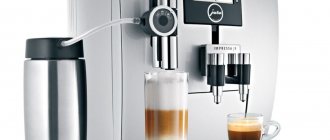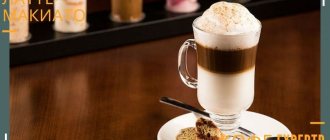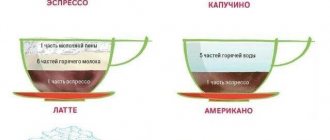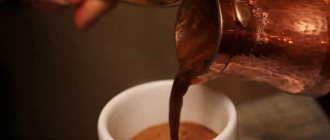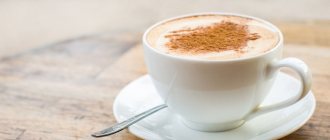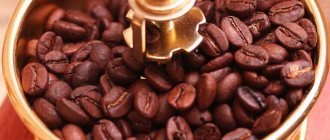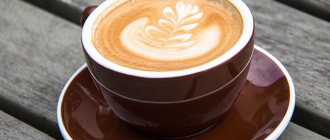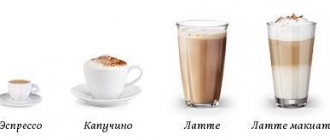Cappuccino coffee - what is it?
The tradition of adding milk to strong coffee to soften the harshness of the taste appeared around the 17th century. We do not have reliable information about who and when became the author of this innovation. But already from the end of the 18th century, coffee with milk was served in all existing coffee houses in Europe.
Cappuccino is a term of Italian origin. Translated, it means “Capuchin”, so the name is associated with the order of Capuchin monks. It was experimentally found that if a well-mixed mixture of milk and cream was added to coffee, a stable foam in the shape of a small pyramid formed on the surface. Because of its resemblance to the white pointed hoods of the Capuchin monks, the coffee was nicknamed “cappuccino.”
The appearance of devices for frothing milk into foam subsequently raised the recipe to the heights of popularity. By the middle of the 20th century, cappuccino became one of the favorite coffee drinks, and it remains so to this day.
Composition of cappuccino coffee
The list of main ingredients for cappuccino consists of only two items:
Freshly brewed coffee
You can take a shot of espresso, brew coffee in a cezve, geyser coffee maker, or simply brew it in a French press. A prerequisite: hand-brewed coffee must be strained so that particles of grounds do not interfere with the enjoyment of your cappuccino.
Milk
The milk should be frothed or frothed until half of its volume is reduced to a smooth, stable foam. You can take milk of any fat content. If you are making cappuccino at home and want to achieve a good, stable and smooth foam without using a cappuccino machine, then choose a mixture of cream and milk in a 1:1 ratio.
Additional cappuccino ingredients:
- Sugar - cane or caramelized sugar complements the taste of the drink well.
- Decorative topping - the most popular topping for cappuccino is cocoa or cinnamon. Both ingredients can be mixed with powdered sugar.
Preparation
It is recommended to start making cappuccino by frothing cool milk, which will immediately heat up during the process. Once foaming is complete and the milk is still in the pitcher (not to be confused with the baseball player), the espresso is prepared. When everything is ready, the milk emulsion is poured into a cup of espresso.
In cafeterias, you can often see how the barista takes milk out of the refrigerator already in the pitcher. Apparently, milk stored this way does not receive excessive degrees when poured into a milk jug at room temperature.
Cappuccino coffee recipe
A classic cappuccino is made with espresso.
Cappuccino proportions:
- 1/3 coffee.
- 1/3 milk.
- 1/3 milk foam.
What is needed to prepare the drink?
- Espresso - 40-50 ml.
- Milk – 80-100 ml.
- Sugar - to taste.
- Flavorings and toppings are optional.
How to make cappuccino?
- Brew a 40-50 ml portion of espresso.
- Pour cooled milk at a temperature of 4-5 degrees into the cappuccino maker and beat until it forms a dense and smooth foam with a finely porous structure. This increases the temperature of the milk, so it is important not to overheat the milk when frothing. It should have a final temperature of 65-75 degrees.
- Pour the prepared coffee into a heated cup, then the milk, and place the remaining foam on the surface of the drink.
- Decorate with sprinkles.
Flavored cappuccino is prepared using the same technology, but topping is added - caramel, chocolate, vanilla or cream. The topping is poured into the coffee before adding the milk.
Cappuccino can be decorated with latte art designs.
Ingredients
Italian experts believe that the ideal amount of espresso is 25 ml: if the espresso is very “short” (not enough), then the odors will not be fully revealed, and if it is very “long” (too much), then they will dissipate. It is ideal to use fresh whole cow's milk, which has the correct organoleptic properties and can produce a velvety foam.
Discussions about the properties of milk in relation to the foam obtained from it, with a mention of the Institute of Chemistry and Milk Technology in the town of Kiel (Germany), were given in one of his own posts with discussions about latte.
Cappuccino coffee at home: recipe
How to make cappuccino at home if you don’t have a coffee machine with a cappuccino maker? You'll have to resort to a proven old recipe.
- Prepare strong coffee in a cezve or French press at the rate of 2 teaspoons per 100 ml of water.
- Mix 50 ml of milk and 50 ml of cream with a fat content of 10-15%.
- Heat the milk and cream mixture in the microwave for 30-60 seconds. The mixture should be hot, but not boiling.
- Using a mixer, immersion blender or whisk, beat the milk-cream mixture for 3-4 minutes until you get a thick, smooth, shiny foam with small bubbles.
- Strain the brewed coffee.
- Pour 50 ml of coffee into a heated cup, then pour in the milk and top with foam.
- Mix cocoa with powdered sugar. Garnish the cappuccino with the resulting topping.
Sugar for cappuccino is served separately.
If you decide to flavor your drink by adding topping, add the flavored syrup before adding the milk.
Differences in the tastes of drinks
Does the development of how drinks are made affect their taste?
Latte has a gentle and creamy milky taste, since it is not as strong as cappuccino. If you don't add sugar to it, it tastes like regular milk. The quality of coffee in this case does not play a very significant role, since its concentration in the drink is low. The foam of the drink is saturated with oxygen, which is why it is loose, light, with a gentle milky taste.
Cappuccino has a distinct coffee taste. Using milk only manages to highlight the aroma of espresso. If you drink it without sugar, you can feel the nutty notes that complement the strong coffee.
The foam is compacted, which has a pronounced milky taste; it can be supplemented with cocoa, cinnamon or chocolate.
Instant coffee cappuccino
Is it possible to make cappuccino from instant coffee? Technically, it’s possible, but the taste and aroma of such a drink will be far from real cappuccino. Instant ersatz cannot replace natural coffee.
If you decide to do such an experiment, then first boil water and prepare instant coffee at the rate of 1 teaspoon per 50 ml of water. You can immediately add topping to your coffee to improve the taste.
Then froth the milk using a cappuccino maker. If you don’t have this device at hand, then heat the mixture of cream and milk and beat with a blender or mixer until foam forms.
Pour the coffee into a heated cup, then add frothed milk and add foam on top. A sprinkle of cocoa or cinnamon will decorate your cappuccino.
Calorie content of cappuccino coffee
The calorie content of cappuccino varies depending on the fat content of the milk, the presence or absence of sugar, and topping.
Cappuccino calorie table
| Composition of the drink | Calorie content of 100 ml cappuccino | Calorie content of a serving of cappuccino (150 ml) |
| Cappuccino with milk 2.5% fat | 36 kcal | 54 kcal |
| Cappuccino with milk 3.2% fat | 41 kcal | 61 kcal |
| Cappuccino with a mixture of milk and cream 10% fat | 60 kcal | 90 kcal |
| Cappuccino with 1 tsp. Sahara | 50 kcal | 74 kcal |
| Cappuccino with sugar and cocoa sprinkles | 54 kcal | 80 kcal |
| Cappuccino with flavoring (topping) without sugar | 54 kcal | 80 kcal |
| Cappuccino with flavoring (topping) and sugar | 67 kcal | 100 kcal |
How much caffeine is in cappuccino
Caffeine is an essential component of all drinks based on natural coffee. Cappuccino is no exception to the rule. Its caffeine content varies from 40 to 70 mg .
Cappuccino made from ground Arabica beans will be slightly less strong due to less caffeine saturation of the beans. If a mixture of Arabica and Robusta was used to prepare the drink, then such coffee contains more stimulating alkaloid, since Robusta has a higher percentage of caffeine than Arabica.
What affects the amount of caffeine
The amount of this alkaloid in a coffee cocktail is influenced by several factors. Among them are the quality of the variety, grinding, roasting, and brewing technique. To find out which coffee has more caffeine, you need to understand each of these points.
Variety
To answer the question of how much caffeine is in the selected drink, first of all, you need to determine the type of beans that were used in the process of its preparation. For convenience, data on the alkaloid content are given in the table.
| Variety | Enzyme content (mg) |
| Arabica | 177 |
| Venezuela | 192 |
| Haitian | 201 |
| Guatemala | 187 |
| Cameroon | 180 |
| Colombia | 195 |
| Costa Rica | 170 |
| Cuban | 195 |
| Mexican | 170 |
| Meleber (India) | 195 |
| Minas | 163 |
| Mocha (Ethiopia) | 160 |
| Nicaragua | 180 |
| Peru | 170 |
| Robusta (Congo) | 325 |
| Robusta (Uganda) | 325 |
| Santos | 160 |
| Salvador | 187 |
| Javanese Arabica | 187 |
The amount of alkaloid is indicated per 1 cup - 170 grams.
Roasting
Also, the question of how much caffeine is in the coffee liquid can be answered by the degree of roasting of the beans. There is a pattern: the amount of alkaloid increases with increasing duration of heat treatment of grains. Lighter grains will contain less invigorating substance.
Grinding
To determine how much caffeine is in a cup, you can also look at the grind. A liquid brewed from freshly ground grains will be stronger than one prepared from pre-crushed raw materials. In freshly ground brewed coffee, the amount of the element is on average set at 60 mg per mug.
Method of preparation and brewing
Particular attention must be paid to the method of preparing the drink. The level of the substance depends on the temperature of the liquid used. The higher the temperature of the water, the more invigorating substance the grains will give to the liquid.
A drink prepared in a Turk will contain less enzyme than one brewed in a coffee machine. This is due to the fact that the beans undergo long-term extraction in the coffee machine. If you prepare liquid in a Turk from strong or medium roasted beans, a cup of the drink will contain approximately 115 mg of caffeine.
A reduced amount is also found in coffee cocktails prepared with milk, such as cappuccino and latte.
Is it possible for pregnant women and children to have cappuccino?
The milk in cappuccino leads many people to believe that the drink has no restrictions on its consumption. The milk component does not replace the presence of a significant dose of caffeine in cappuccino . Milk only softens the effect of caffeine, reducing the severity of its effects.
The caffeine contained in cappuccino can have a stimulating effect on the nervous system, which is especially vulnerable in pregnant women and children. It is better for them to refrain from drinking cappuccino, as well as all other types of coffee-containing drinks, so as not to put their health at risk.
Pregnant women and children should choose cocoa or hot chocolate instead of cappuccino.
Cappuccino coffee cups
Cappuccino is a voluminous drink, so 180-200 ml cups are suitable for serving it. You can take larger containers, but the peculiarity of serving cappuccino is that the milk foam should not only be flush with the edge of the cup, but even slightly protrude beyond its edge. Therefore, dishes should be selected based on the portion that is prepared in your kitchen.
- Preference is given to cups in the shape of an inverted dome, with an extension at the top. In such dishes, the patterns on the surface of the cappuccino are clearly visible.
- Sometimes cappuccino is served in glass glasses for Irish coffee. The height of the foam is clearly visible in them.
- The best glassware for cappuccino remains ceramic cups with thick walls. In them, the drink retains its temperature longer, while in glass glasses the coffee cools down faster.
Traditional glassware for cappuccino is a white ceramic cup with a volume of 200 ml with thick walls.
The nuances of coffee consumption
The usual approach calls for drinking before noon. Italians are convinced that these are morning drinks because they contain milk. If you familiarize yourself with Russian information channels, there are no strict restrictions, there are only tips.
How to drink a latte:
- Suitable for consumption between meals, as it can be worn out in huge volumes.
- There is not enough caffeine in its composition, so you can drink it even in the evening.
- Usually, a napkin, spoon and straw are served with the glass. We hold the glass with a napkin so as not to burn ourselves, stir the drink with a spoon, and drink with a straw.
- Fruit and curd flavors are in amazing harmony with the taste of latte. Cheesecakes, soufflés and mousses are the perfect addition to the drink.
- The delicate palette of the drink is stunningly complemented by nut-flavored sweets or chocolate ice cream.
- If you prefer low-calorie desserts, it is recommended to pay attention to raspberry sorbet, strawberry pudding or fruit marshmallow.
For cappuccino lovers:
- The composition contains a high concentration of caffeine, so they should complete a light lunch or snack.
- They drink it through foam. The delicate milky flavor helps bring out the unique bitter taste of espresso.
- It is not customary to stir cappuccino; it is a sign of bad taste.
- In order to more fully experience the versatility of the taste, adding sugar to the drink is contraindicated.
- Creamy and chocolate flavors blend amazingly with cappuccino. Buttercream, panna cotta and brownies are perfect.
- If you like to treat yourself to unusual desserts, we recommend that you pay attention to peach mousse or coconut cookies.
- If you have to count calories, then choose meringue or strawberry jelly - desserts that are virtually fat-free.
The history of coffee is very rich. Now this is a trend, as it was many years ago, because every connoisseur is offered a huge number of types of coffee: Americano, mochaccino, glasse, raf and simple instant drinks, for example, coffee white. They are made using different methods, so try and choose.
Making cappuccino in a coffee machine is a new life for your coffee lover.
Cappuccino: difference from other coffee recipes
A cappuccino recipe is one of the options for coffee-containing drinks, of which there are a great variety. What is the difference between the most popular traditional coffee menu recipes?
What is the difference between a cappuccino and a latte?
- Proportions. A latte contains much more milk than a cappuccino. A latte contains only 1/5 coffee and 4/5 milk.
- Cooking method. A latte is made by adding coffee to milk. To make cappuccino, on the contrary, milk is poured into coffee.
- Volume. A latte serving is approximately 350-380 ml, sometimes more. Cappuccino is served in portions from 180 to 250 ml.
- The latte tastes milky and sweet. The influence of coffee on the bouquet of the drink is minimal. The taste of cappuccino is coffee and milk, the coffee in it is felt brightly.
What is the difference between a cappuccino and a mochaccino?
- Compound. Mochaccino, in addition to coffee and milk, includes chocolate syrup or hot chocolate.
- Proportions. Mochaccino contains approximately ¼ part coffee and ¾ other ingredients. Compared to cappuccino, the share of coffee is reduced.
- Cooking method. In mochaccino, coffee is added after milk and chocolate, unlike cappuccino.
- Taste. The bouquet of mochaccino is chocolate-milk, sweet, with coffee notes, it differs from the coffee-milk taste of cappuccino.
What is the difference between a cappuccino and an Americano?
- Compound. Americano does not have foamed milk or a high head of foam; only espresso, heavily diluted with water, is used to make it.
- Taste. Americano has a weakened coffee taste, without the dairy component. Even if Americano is diluted with milk, it will be very different from the bright coffee and milk flavor of cappuccino.
What is the difference between cappuccino and espresso?
- Compound. Espresso is coffee brewed in an automatic coffee machine. Prepared without additives, it is the basis for many other coffee drinks, including cappuccino.
- Volume. A serving of espresso ranges from 40 to 80 ml. A cappuccino has a volume of at least 150 ml and can go up to 250 ml.
What is the difference between a cappuccino and a macchiato?
- Proportions. Macchiato, like cappuccino, contains foamed milk, but in much smaller quantities. The classic macchiato recipe is 1/3 milk and 2/3 coffee, while a cappuccino is 1/3 coffee and 2/3 milk.
- Taste. Milk in a macchiato only emphasizes the bouquet of coffee, while milk in a cappuccino significantly softens the harshness of the coffee, blurring the richness of the coffee.
- Cooking method. To obtain a macchiato, coffee is poured into a small portion of frothed milk to create the characteristic coffee stains on the surface of the foam, which give the drink its name. "Macchiato" means "spotted" in Italian.
What is the difference between cappuccino and coffee with milk?
- Cooking method. For cappuccino, milk is frothed using a blender or cappuccino maker.
- Compound. In cappuccino, approximately 1/3 is delicate milk foam, which gives the drink a special taste and recognizable appearance. Coffee with milk does not contain whipped foam.
- Proportions. The milk component for coffee with milk can be anything - half a cup or one tablespoon. The proportions of a classic cappuccino are regulated: 1/3 milk, 1/3 coffee, 1/3 milk foam.
What is the difference between cappuccino and raf coffee?
- Compound. Rough coffee is made from cream, coffee and sugar. The composition of cappuccino is milk and coffee, cream is used much less frequently, and sugar is added as desired.
- Cooking method. To prepare raf coffee, all ingredients are mixed and whipped. For cappuccino, only milk is frothed.
Difference in cooking process
Despite the similar composition, the development of the production of drinks is very different.
There are several methods you can use to make a latte: latte macchiato and traditional latte. To make the first one, it is recommended to pour previously heated milk or its mixture with cream into a glass, and then add coffee. As for the traditional version, it is prepared like cappuccino, only the proportions are different. Foam can be added before pouring in the espresso or added at the very end. Before this, lattes were not stirred, but sought to achieve a layered structure; now the trend is for a homogeneous drink, so mixing is allowed.- To make cappuccino, pour a portion of coffee into a container, then add milk that has previously undergone the frothing process, and spread the resulting foam on top. It is not customary to stir the drink.
How to drink cappuccino correctly?
The ideal way to drink cappuccino is to drink it without stirring, passing the coffee and milk through a layer of airy foam. In order to avoid mixing, sweet toppings were added to cappuccino for those with a sweet tooth.
Some skim off the foam with a spoon and only then start drinking coffee. This is not entirely correct, since with this use there is no opportunity to enjoy a real bouquet of cappuccino.
According to gourmets, sugar spoils the taste of cappuccino, so coffee lovers do not put any sweeteners in their cappuccino. Silky foam and milk sufficiently soften the coffee bitterness.
Italians believe that cappuccino time is morning until noon, or better yet, before 11 o’clock. They do not advise drinking it after meals, as milk slows down and impairs digestion.
Milk foam structure
Latte foam is characterized by looseness; it is not able to hold even the lightest elements created for decoration on its surface. In a latte, its layer is not very high; it is only a decoration for the coffee cocktail, and not its full-fledged flavor component.
As for cappuccino, the foam in it is more dense, despite the saturation with air. Cocoa or cinnamon powder sprinkled on top, sugar stays on the surface of the film for a long time without settling down. The foam layer should always be the highest.
The foam for making latte is whipped a little less than for cappuccino. To achieve the best results for cappuccino, use milk with a high percentage of fat content.
Cappuccino: our conclusion
- A coffee drink with the addition of frothed milk and a high, cone-shaped head of foam.
- It has an average calorie content and strength, the invigorating effect is reduced due to the partial neutralization of caffeine by milk.
- The main taste is coffee-milk, pronounced.
- It's better to drink without sugar.
- The optimal time for consumption is before 11 am.
- It has a number of differences from other recipes for coffee-containing drinks.
- The most popular drink in European and American coffee shops.
